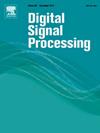基于自学习的多图像联合超分辨率和子像素配准
IF 3
3区 工程技术
Q2 ENGINEERING, ELECTRICAL & ELECTRONIC
引用次数: 0
摘要
多图像超分辨率(MISR)是指增强代表同一场景的低分辨率(LR)图像堆栈的空间分辨率。尽管最近开发出了许多基于深度学习的单图像超分辨率(SISR)技术,但深度学习尚未被广泛用于 MISR,尽管它可以实现更高的重建精度,因为可以从一叠低分辨率图像中提取更多信息。深度网络在解决 MISR 问题时遇到的主要障碍之一是作为网络输入的 LR 图像数量的不稳定性。这阻碍了采用端到端学习方法的可行性,因为输入图像数量的变化使得网络难以构建训练数据集。本文提出了一种基于自学习的方法,可同时对多幅 LR 图像进行超分辨率和子像素配准。本文提出的方法只将 LR 图像作为输入,而不使用任何真实的目标 HR 图像来训练神经网络;也就是说,本文提出的方法不需要额外的训练数据集。因此,建议的方法很容易处理不同数量的输入图像。据我们所知,这是第一次仅使用 LR 图像来训练神经网络,以执行 MISR 和子像素联合配准。实验结果证实,与其他基于深度学习的方法相比,拟议方法生成的 HR 图像在定量和定性评估方面都取得了更好的结果。本文章由计算机程序翻译,如有差异,请以英文原文为准。
Self-learning based joint multi image super-resolution and sub-pixel registration
Multi Image Super-resolution (MISR) refers to the task of enhancing the spatial resolution of a stack of low-resolution (LR) images representing the same scene. Although many deep learning-based single image super-resolution (SISR) technologies have recently been developed, deep learning has not been widely exploited for MISR, even though it can achieve higher reconstruction accuracy because more information can be extracted from the stack of LR images. One of the primary obstacles encountered by deep networks when addressing the MISR problem is the variability in the number of LR images that act as input to the network. This impedes the feasibility of adopting an end-to-end learning approach, because the varying number of input images makes it difficult to construct a training dataset for the network. Another challenge arises from the requirement to align the LR input images to generate high-resolution (HR) image of high quality, which requires complex and sophisticated methods.
In this paper, we propose a self-learning based method that can simultaneously perform super-resolution and sub-pixel registration of multiple LR images. The proposed method trains a neural network with only the LR images as input and without any true target HR images; i.e., the proposed method requires no extra training dataset. Therefore, it is easy to use the proposed method to deal with different numbers of input images. To our knowledge this is the first time that a neural network is trained using only LR images to perform a joint MISR and sub-pixel registration. Experimental results confirmed that the HR images generated by the proposed method achieved better results in both quantitative and qualitative evaluations than those generated by other deep learning-based methods.
求助全文
通过发布文献求助,成功后即可免费获取论文全文。
去求助
来源期刊

Digital Signal Processing
工程技术-工程:电子与电气
CiteScore
5.30
自引率
17.20%
发文量
435
审稿时长
66 days
期刊介绍:
Digital Signal Processing: A Review Journal is one of the oldest and most established journals in the field of signal processing yet it aims to be the most innovative. The Journal invites top quality research articles at the frontiers of research in all aspects of signal processing. Our objective is to provide a platform for the publication of ground-breaking research in signal processing with both academic and industrial appeal.
The journal has a special emphasis on statistical signal processing methodology such as Bayesian signal processing, and encourages articles on emerging applications of signal processing such as:
• big data• machine learning• internet of things• information security• systems biology and computational biology,• financial time series analysis,• autonomous vehicles,• quantum computing,• neuromorphic engineering,• human-computer interaction and intelligent user interfaces,• environmental signal processing,• geophysical signal processing including seismic signal processing,• chemioinformatics and bioinformatics,• audio, visual and performance arts,• disaster management and prevention,• renewable energy,
 求助内容:
求助内容: 应助结果提醒方式:
应助结果提醒方式:


